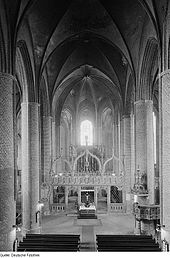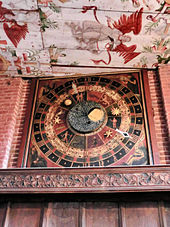St. Marien (Stendal)


The Marienkirche is a parish church in the center of Stendal from the brick Gothic period .
history
In the 12th century, a Romanesque basilica was built on the site of today's St. Mary's Church , some of the furnishings of which are still preserved today. In the late 14th century, the west building was extended with the double tower facade; the towers were lengthened. In 1420 the new construction of the Marienkirche began as a late Gothic hall church . A portal porch, called Paradise , was built on the south side . The previous Romanesque building was demolished a few years later. Until 1447 the church was vaulted . The church consecration took place on August 24, 1447. Between 1470 and 1473 the Marienzeitenkapelle was built. In 1471 the high altar was erected. After the Reformation , in 1538 Justus Jonas the Elder gave the first Protestant sermon in the Marches of Brandenburg in the Marienkirche . The towers were completed in the 16th century. In 1580 an astronomical clock was installed. The Marienkirche was the main parish church of the Hanseatic merchants.
During the Thirty Years' War the Hieronymus Altar was kidnapped because it was believed that it had been created by Albrecht Dürer . Today it is in the Kunsthistorisches Museum Vienna . In 1794, Paradise was torn down and a sandstone relief from 1420 was placed above the portal .
In 1834–1844 and 1965–1971 major repairs took place. From 1995 the roof was re-covered with copper , several bells restored and the windows re-glazed.
Location, architecture and equipment

The Marienkirche stands in the center of Stendal immediately east of the town hall , which in turn borders on the market. The north end of Stendal's main shopping street is on the east side. Marienkirchstraße is located south of the church. The St. Nicholas Cathedral , which also has two towers, is about a kilometer away.
The Marienkirche is built in the brick Gothic style. It has two 82-meter-high towers and thus the second highest church towers in the Altmark after St. Stephan in Tangermünde . The two towers are connected by a bridge with a turret . There is a second roof turret on the roof. The church is a three-aisled hall church. The side aisles are led around the inner choir as a walkway and form the structurally complex hall choir . Numerous chapels adjoin the aisles. The equipment includes the high altar , the pulpit , the baptismal font , the astronomical clock , the organ and the bells . From the earlier basilica, figures of the apostles in the choir screen from the 13th century and a triumphal cross from the 14th century have been preserved.
The eight meter high high altar was painted in the old Dutch style in 1470 and placed in St. Mary's Church the following year. It is a winged altar and shows, among other things, scenes from the life of Mary .
The richly decorated pulpit was moved to its current location on the southern first pillar in 1844. The “basket” from 1566 stands on balusters . On the pulpit there is a series of paintings on which, among other things, Jesus can be seen in front of the city silhouette of Stendal with the towers of the Marienkirche. The sound cover is five-sided.
The baptismal font belongs to the Gothic bronze fifths . It was made in Lübeck , erected in the central nave in 1474 and moved to the Marienzeitenkapelle in 1844, which still serves as a baptistery today. It is richly decorated with figures. Male and female representations of saints alternate.
Astronomical clock
The clock belongs to the type of Hanseatic astronomical clock . It is located below the organ gallery . Its dial is three by three meters and shows a 24-hour day. The large hand makes one turn in two hours. The position of the sun and the earth's moon are shown by models. A star disc, in which an opening shows the lunar cycle, serves as a counterweight to the models. The inner number ring shows the date. The clock weighs 100 kilograms and the pendulum is 3.25 meters long. The watch must be wound every five days. It is driven by a 65 kilogram counterweight and a pulley. In 1856 the clockwork was rebuilt by what was then the lower Küster and then deliberately destroyed again. In the 1970s, the master goldsmith Oskar Roever from Stendal began to restore the watch. On May 14, 1977, it was ready to be opened to the public.
Scherer organ
The organ is on a gallery at the west end of the church. The Rückpositiv with the inscription "1580" was originally on a small organ gallery on the south wall of the nave. It was built by Hans Scherer the Elder in 1580 and at that time had 29 stops on two manuals and a pedal . Today it has around 2,600 pipes and 38 sounding voices on three manuals, a mechanical action and an electrical registry. A fundamental restoration has been sought for several years (status 2011).
|
|
|
|
||||||||||||||||||||||||||||||||||||||||||||||||||||||||||||||||||||||||||||||||||
- Pair : I / II, II / III
Bells
The Stendal Marienkirche has twelve bells. The four larger bells form the main ring ; The Marienglocke and Lazy Anna were cast by one of the most important bell founders of the Middle Ages, Gerdt van Wou . The Lazy Anna , has its name therefore that it is never a soloist to hear; it rings only in conjunction with the other bells.
Bells 5–9 form the choir bells , with the smallest bell, cantata , hanging over the crossing in the roof turret that has yet to be restored . On festive days (Christmas, Easter, Whitsun, parish fair on August 24th), the choir bells for five minutes with a short break of one minute before the main ringing of bells 1–4.
Three bells serve the Uhrschlag, the former district bell as second character bell was integrated into the choir of bells and act in place of their two bells for the quarter-hour strike. These hang with the medieval hour bell in the roof turret on the bridge between the two west towers.
With the help of the specially founded bell association, the bell has been extensively renovated and expanded.
| No. | Surname | Casting year | Foundry, casting location | Diameter (mm) | Mass (kg) | Strike tone (16th note) | tower |
|---|---|---|---|---|---|---|---|
| 1 | Mary's bell or storm bell | 1490 | Gerhard van Wou | 1.984 / 1.989 | 4,980 | as 0 +9 | Mittelbau |
| 2 | New bell or osanna | 1616 | Hans Nuessel | 1,848 | 3,690 | b 0 +5 | North tower |
| 3 | Lazy Anna | 1490 | Gerhard van Wou | 1,574 | 2,490 | ces 1 +10 | South tower |
| 4th | Morning and evening bells, vespers or five bells | 1598 | Heinrich Borstelmann | 1,316 | 1,400 | d 1 +9 | South tower |
| 5 | (Sugar loaf bell) | after 1300 | anonymous | 585 | 140 | as 2 +3 | South tower, east window |
| 6th | Peace bell | 2001 | Eifeler bell foundry HA Mark, Brockscheid | 534 | 102 | f 2 +8 | South tower, east window |
| 7th | Drawing bellI
|
1522 | anonymous | 514 | 90 | as 2 +3 | South tower, south window |
| 8th | Drawing bellII
|
1497 | Hermann Vogel | 460 | 55 | b 2 −1 | South tower, south window |
| 9 | Hour bell | 1481 | Mateus Moring | 925 | 500 | h 1 +5 | Roof turret (bridge) |
| 10 | Quarter bellI
|
1997 | Mark, Brockscheid | 530 | 90 | ges 2 +4 | Roof turret (bridge) |
| 11 | Quarter bellII
|
2007 | Petit & Gebr. Edelbrock , Gescher | 40 | it 3 | Roof turret (bridge) |
(Table:)
In 2020, a carillon with 24 bells in the tone range c 3 to d 5 will be installed in the newly built roof turret .
use
The Marienkirche is the parish church of the Protestant town of Stendal. It used to serve as a council church. In the church there are services, but also organ concerts and other concerts, as well as occasional theater performances.
literature
- Richard Zander: The Marienkirche in Stendal. Evangelisches Pfarramt St. Marien, Stendal 1953 (brochure).
- Kurt Rönnebeck: The St. Marienkirche in Stendal. Manfred Reiher, Bismark 1993 (brochure).
- Martina Sünder-Gaß: St. Marien in Stendal (= Steko art guide. No. 35). Verlag Janos Stekovics, Wettin-Löbejün OT Dößel, 2010 ISBN 978-3-89923-236-3 (brochure).
Web links
- Evangelical parish, St. Marien
- Förderverein Glocken St. Marien eV
- Information on the astronomical clock from Oskar Roever
Individual evidence
- ↑ a b Website of the municipality / Middle Ages ( Memento from February 12, 2013 in the web archive archive.today )
- ↑ a b c website of the municipality / modern times ( memento from February 12, 2013 in the web archive archive.today )
- ↑ The altar at stadtgemeinde-stendal.de, accessed on September 23, 2018.
- ↑ St. Marien Church, Stendal . In: European Route of Brick Gothic . ( eurob.org [accessed September 22, 2018]).
- ↑ The Astronomical Clock at stadtgemeinde-stendal.de, accessed on September 23, 2018.
- ↑ The organ at stadtgemeinde-stendal.de, accessed on September 23 2018th
- ↑ a b Constanze Treuber u. a .: Cast diversity. Bells in Saxony-Anhalt. Hinstorff, Rostock 2007, p. 141.
- ↑ Ringing the St. Marien bell (as 0 ) by Geert van Wou on YouTube .
- ↑ Bärbel Hornemann: Förderverein Glocken St. Marien eV Stendal
- ↑ Information on the carillon
- ↑ New carillon for Stendal's Marienkirche , mdr.de, August 24, 2020.
Coordinates: 52 ° 36 ′ 20 ″ N , 11 ° 51 ′ 38 ″ E

